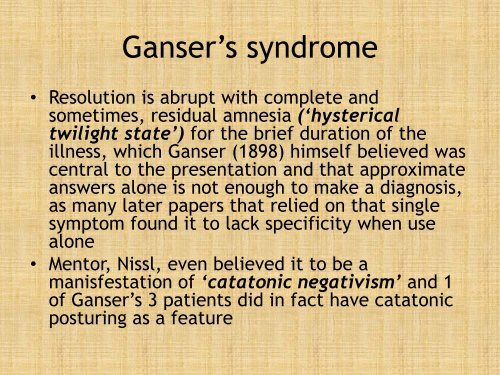The Pseudodementia Dilemma - 1st World Congress on Healthy ...
The Pseudodementia Dilemma - 1st World Congress on Healthy ... The Pseudodementia Dilemma - 1st World Congress on Healthy ...
Ganser’s syndrome • Resolution is abrupt with complete and sometimes, residual amnesia (‘hysterical twilight state’) for the brief duration of the illness, which Ganser (1898) himself believed was central to the presentation and that approximate answers alone is not enough to make a diagnosis, as many later papers that relied on that single symptom found it to lack specificity when use alone • Mentor, Nissl, even believed it to be a manisfestation of ‘catatonic negativism’ and 1 of Ganser’s 3 patients did in fact have catatonic posturing as a feature
Ganser’s syndrome •
- Page 1 and 2: Organised by: Co-Sponsored: Malaysi
- Page 3 and 4: Content • Pseudodementia<
- Page 5 and 6: Depressive pseudodementia (DPD) •
- Page 7 and 8: DPD (con’t) • Jacoby and Levy o
- Page 9 and 10: DPD (con’t) • However, consider
- Page 11 and 12: D/D Dementia and DPD (Small et al,
- Page 13: Ganser’s syndrome • 1 st descri
- Page 17 and 18: Ganser’s syndrome • In modern p
- Page 19 and 20: Hysterical pseudodementia • Core
- Page 21 and 22: Simulated dementia • Memory loss
- Page 23 and 24: D/D from Functional disorders • S
- Page 25: Thank You Main source: Lishman WA:
Ganser’s syndrome<br />
• Resoluti<strong>on</strong> is abrupt with complete and<br />
sometimes, residual amnesia (‘hysterical<br />
twilight state’) for the brief durati<strong>on</strong> of the<br />
illness, which Ganser (1898) himself believed was<br />
central to the presentati<strong>on</strong> and that approximate<br />
answers al<strong>on</strong>e is not enough to make a diagnosis,<br />
as many later papers that relied <strong>on</strong> that single<br />
symptom found it to lack specificity when use<br />
al<strong>on</strong>e<br />
• Mentor, Nissl, even believed it to be a<br />
manisfestati<strong>on</strong> of ‘catat<strong>on</strong>ic negativism’ and 1<br />
of Ganser’s 3 patients did in fact have catat<strong>on</strong>ic<br />
posturing as a feature



